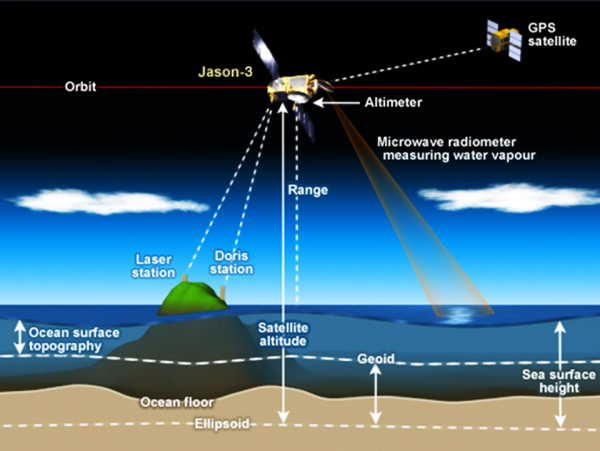Context:
Since December 2023, the northern part of India has been grappling with heavy fog including Bihar, Uttar Pradesh, Uttarakhand, Haryana, Delhi, and Punjab.
Types of weather Satellite India:
The Kalpana 1 and INSATs 3A, 3D, and 3DR satellites aided India’s weather monitoring and warning services.
Kalpana 1: It is the first dedicated meteorological satellite launched by the Indian Space Research Organisation on 12 September 2002.
- This was the first satellite launched by the PSLV into the Geo-stationary orbit. The satellite was originally known as MetSat-1. It was renamed as Kalpana-1.
- The satellite features a Very High Resolution scanning Radiometer (VHRR), for three-band images and a Data Relay Transponder (DRT) payload. India deactivated Kalpana 1 in September 2017, after 15 years in orbit.

INSAT 3D and 3DR: It had a launch mass in 2016 and carried an upgraded VHRR, a sounder, a data-relay transponder and a search-and-rescue transponder.
- Both satellites are currently active in geostationary orbits around the earth, at inclinations of 82 degrees and 74 degrees east longitudes respectively.
INSAT–3A: This is the third satellite in INSAT–3 series is a multipurpose satellite for providing telecommunications, television broadcasting, meteorological and search and rescue services.
- For Meteorological observation, INSAT–3A carries a three-channel Very High-Resolution Radiometer (VHRR). In addition, INSAT–3A carries a Charge Coupled Device (CCD) camera which operates in the visible and short-wave infrared bands providing a spatial resolution of 1 km.
How does the satellite track snow?
Studied through Color:
According to a paper published by IMD scientists in February 2019, the INSAT 3D satellite has a red-green-blue, or RGB, imager whose images’ colors are determined by two factors:
- Solar reflectance: Solar reflectance is a ratio of the amount of solar energy reflected by a surface and the amount of solar energy incident on it.
- Brightness temperature: Brightness temperature has to do with the relationship between the temperature of an object and the corresponding brightness of its surface.
Day Microphysics:
INSAT 3D’s ‘day microphysics’ data component studies solar reflectance at three wavelengths:
- 0.5 µm (visible radiation): The strength of the 0.5-µm visible signal determines the amount of green colour.
- 1.6 µm (shortwave infrared radiation): The strength of the 1.6-µm shortwave infrared signal, the amount of red colour.
- 10.8 µm (thermal infrared radiation): The strength of the 10.8-µm thermal infrared signal, the amount of blue colour.
That is, detectors onboard the satellite track radiation coming from over India in these wavelengths.
Night Microphysics:
The satellite’s ‘night microphysics’ component is a little more involved.
Two colours are determined not by a single signal but by the strength of the difference between two signals.
- Red colour: The computer determines the amount of red colour according to the difference between two thermal infrared signals: 12 µm and 10 µm.
- Green colour: The amount of green colour varies according to the difference between a thermal infrared and a middle infrared signal: 10.8 µm and 3.9 µm.
- Blue colour: The amount of blue colour is not a difference but is determined by the strength of a thermal infrared signal of wavelength 10.8 µm.

How do the colour schemes help?
- The major applications of this colour scheme are an analysis of different cloud types, initial stages of convection, maturing stages of a thunderstorm, identification of snow area, and the detection of fires.
Indian weather Satellite helps
- Eye in the Sky: INSAT 3D and 3DR satellites, equipped with red-green-blue (RGB) imagers, watch over India from their strategic geostationary orbits. These imagers analyze sunlight bouncing off Earth and temperature variations to identify different weather patterns in real time.
- 24/7 Vigilance: Day and night, the satellites’ “microphysics” capabilities track weather changes with equal finesse. This continuous monitoring is crucial for accurate forecasts.
- Trace Snow or Cloud differences: The satellites can distinguish between snow and clouds based on their unique spectral signatures, improving weather predictions.
- Storm Warnings Aplenty: By combining day and night data, scientists can predict cyclones and thunderstorms more effectively, giving communities critical lead time to prepare.
- Upgraded radiometers: Like those on INSAT 3DR offers superior resolution and functionality compared to earlier models, enhancing weather data collection.
- Atmospheric sounders: These take the pulse of the air, measuring temperature, humidity, and water vapour to create detailed atmospheric profiles for precise weather analysis

